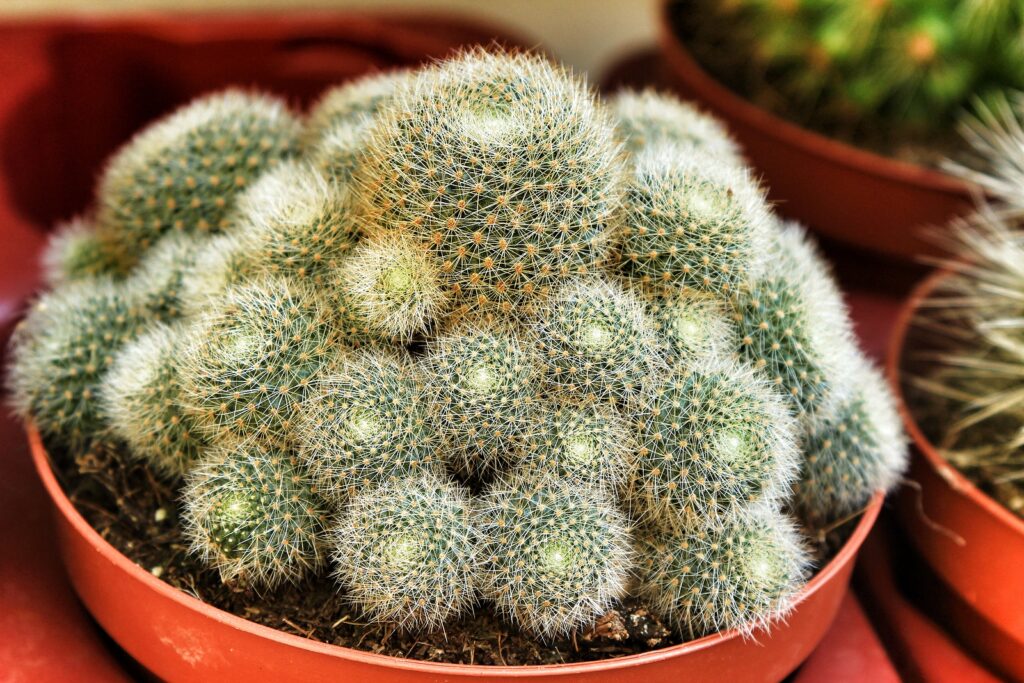Rebutia–commonly called crown cactus–are small cacti about the size of an apple. They are cylindrical or spherical plants that bear funnel-shaped flowers in a circle around the base (thus the common name crown cactus). Rebutia produces large brightly colored flowers in red, orange, pink, yellow, purple, and white.
Rebutia flowers appear profusely in spring and summer, opening in the morning, closing at night, and each lasting for several days. Rebutia only lives 3 to 4 years, seemingly exhausted by its flowering effort, but produces numerous offsets before it dies.
Rebutia are tough plants; they can withstand chilly temperatures as low as 30°F but grow best in a warm location with bright light. Indoors they need a bright spot and more light than the average houseplant.
When Rebutia forms small, reddish pimples among the basal spines in spring; the plant should be relocated to a warm, sunny spot—this is the earliest indication of flowering.
Rebutia propagates easily from seeds or cuttings; they are often hybridized. Members of the genera Sulcorebutia and Weingartia have been included in the Rebutia genus. There are more than 25 species of Rebutias.
Get to know Rebutia
- Plant type: Cactus, a hedgehog cactus
- Hardiness temperature: 30℉ (-1.1℃)
- Optimal growing temperature: day, 65° to 85°F (18° to 29°C); night, 50° to 65°F (10° to 18°C).
- Shape and size: Compressed, clustering, globular cacti grows to about 6 inches (15cm) tall; instead of true ribs, they have small nipplelike projections.
- Flowers: Abundance of large, highly colored blooms in red, orange, pink, yellow, purple, and white; small, reddish pimples that form among the basal spines is an early indication of flowering
- Bloom time: Summer
- Common name: Crown cactus
- Genus name: Rebutia
- Family name: Cactaceae
- Origin: Alpine grasses of South America, Argentina

Planting Rebutia
- Grow Rebutia in a airy, sunny place.
- Indoors grow Rebutia in filtered sun, with 4 hours direct winter sun daily, from southern or western exposure. Does well under artificial light, needing 12 light-hours daily. Air circulation is important.
- Plant Rebutia in a well-drained cactus mix.
- Rebutia can be grown indoors; it requires more bright light than most houseplants.
How to water and feed Rebutia
- Keep the soil just moist, but not wet during the growing season. Let soil dry slightly between moderate waterings. Avoid overwatering.
- Rebutia should have a dry winter dormancy period.
- Rebutia wants humidity of 30% to 35%.
- Feed Rebutia every 6 weeks during growing season, with low-nitrogen, high-potassium fertilizer; for plants at least 1 year old.
Rebutia care
- Pot-on Rebutia when offsets crowd against sides of pots or roots overcrowd pot space. Use a broad pot to accommodate shallow roots.
- To encourage Rebutia blooming, induce winter rest. Place Rebutia in a cool location, 40° to 50°F (4° to 10°C). Water just enough to keep the plant from shriveling and withhold fertilizer. When buds appear, give slightly more water and warmer temperature. Resume regular care when buds show red.
- Rebutia tends to re-seed itself.
- Propagate Rebutia by offsets in summer, or seeds.
- Sprouts grow easily from roots; they can be separated and replanted.
- Redutia is susceptible to attack by spider mites.
Rebutia species to grow
- Rebutia albiflora. Small, fragile looking, clustering species. Hairy spines, slender stems, and pure white flowers.
- R. heliosa. Densely covered with short, silvery spines. Slender, reddish orange flowers.
- R. kupperana. Small grayish brown globe with short brown spines; red and orange flowers.
- R.minuscula (red crown). Clustering globular species has spherical, 1 ½ inch (4 cm) wide, red-green stems; short white spines; profuse brick red flowers.
- R.m grandiflora. Similar to R. minúscula except that flowers appear on long, narrow tubes.
- R. miniscula. Red crown cactus. 2-inch (5 cm) globes with white spines; flowers are crimson.
- R. pseudodeminuta (wallflower crown). Slender spines are white with brown tips; golden yellow flowers are 2 inches long.
- R. senillis (fire crown cactus). Dark green cactus covered with a mass of snow white spines; grows 3 inches (8 cm) tall and 2 ¾ inches (7 cm) thick; brilliant red flowers are featured against dense white spines.
- R. spinosissima. Close-set areoles with many bristlelike, radial white spines; delicate blood red flowers.















